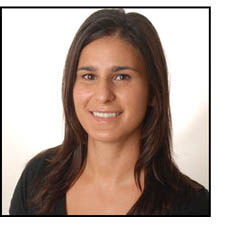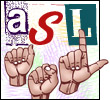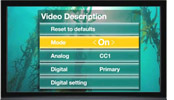|
|
November 2012 
Fill Your Cornucopia With Blessings (Titles) From DCMP
 Are you looking to give your students a different perspective on Thanksgiving, or a new dish to add to your repertoire? Well, DCMP has plenty of accessible ingredients for you to create your own Thanksgiving experience for students who are deaf, blind, or deaf-blind. Are you looking to give your students a different perspective on Thanksgiving, or a new dish to add to your repertoire? Well, DCMP has plenty of accessible ingredients for you to create your own Thanksgiving experience for students who are deaf, blind, or deaf-blind.
DCMP has the traditional titles that capture the true meaning and spirit of Thanksgiving. But you can also use described and captioned media titles to broaden your students' horizons. Break away from tradition and expand the minds of your students as you create a new "perspect-dish" on Thanksgiving.
Thanksgiving can serve as the foundation for lessons on nutrition, geography, culture(s), animal migration, and the changing seasons. Pick your accessible ingredients wisely by searching our catalog and finding Native American Heritage Month titles (Come Celebrate With Me: Native American Powwow, Pocahontas, A History of American Indian Achievement: The Emergence of the American Indian Hero, and Comparing the Lives of Native Peoples) and American History titles (Thanksgiving Shared: Native Americans and Pilgrims, Molly’s Pilgrim, America—The Story of Us: Rebels, and Our Early United States: Colonial Settlements). Also, view these brand new accessible videos for November!
Related Links:
Related DCMP Resources:
|
|
Early Learning: Is TV/Video Watching (Or Other "Screen Time") Bad for Young Children?
Electronic Babysitter or Powerful Learning Tool?
 The effect of television on children, especially on babies, is an intensely controversial subject. Every year rafts of studies and statistics appear about children's television habits, and some of them may seem alarming. For example, the American Academy of Pediatrics, the White House Task Force on Childhood Obesity, and others often encourage professionals to work with parents to discourage any amount of screen time (including television, videos, digital media, video games, mobile media, cell phones, and the Internet) for children under 2 years of age, and also recommend strict limits of two hours or less screen time for preschoolers (age 2 through 5). The effect of television on children, especially on babies, is an intensely controversial subject. Every year rafts of studies and statistics appear about children's television habits, and some of them may seem alarming. For example, the American Academy of Pediatrics, the White House Task Force on Childhood Obesity, and others often encourage professionals to work with parents to discourage any amount of screen time (including television, videos, digital media, video games, mobile media, cell phones, and the Internet) for children under 2 years of age, and also recommend strict limits of two hours or less screen time for preschoolers (age 2 through 5).
However, research findings remain divided and can be confusing to educators and parents. Some children's media researchers have found no evidence to support the belief that screen media are inherently harmful, noting the extremes of some media providing exciting educational content with other content being educationally worthless. The evidence from public broadcasting's Ready To Learn initiative suggests that when television shows and electronic resources have been carefully designed to incorporate what is known about effective instruction, they serve as positive and powerful tools for teaching and learning. Further, the National Association for the Education of Young Children and the Fred Rogers Center for Early Learning and Children's Media states:
Today's children are growing up in a rapidly changing digital age that is far different from that of their parents and grandparents. A variety of technologies are all around us in our homes, offices, and schools. When used wisely, technology and media can support learning and relationships. The amount of time children spend with technology and media is important, but how children spend time with technology must also be taken into account.
Caregivers Are the Key
Parents, grandparents, teachers, and other caregivers are the key. As early as the 1980s, communications researchers discovered that the children whose parents talk about Sesame Street as they watch learn more from the show. Caregivers who coview with their children help guide their attention to media features salient for learning.
For children who are deaf or blind, issues of equality and access have significant implications. About children with a hearing loss, parent Sheena McFeely writes:
Put a Deaf child in front and all h/she gets are the body movements, colors, shapes, and anything that's visually entertaining to their eyes. If blessed with a great parent, their mom or dad would be sitting right next to that child explaining everything. Yes, I've heard stories where some parents signed a whole TV show for their Deaf child. Deaf children especially under the age of 6 are at huge disadvantage, and they are most likely unable to read captions and comprehend visuals quickly at the same time. Captioning is nothing like reading from a book where we can simply take our time. In turn, we hold the responsibility to explain each element that turns into life on the screen.
For years, caregivers have live-described TV programs and videos for their visually impaired children. Considerations for these children are similar to those for others, and Susan LaVenture from the National Association of Parents for the Visually Impaired writes:
Your preschooler is surrounded by technology, and as she grows, it is likely to become an important part of her independence. Radios, portable CD or MP3 players, tape recorders, and DVD players are forms of technology that many families use. Your daughter may enjoy listening to music or watching a video, but may not realize how you make it start and stop. Show her the equipment and consider adding tactile or color markings to the main keys, such as Play and Stop, so that she can operate the technology herself when you feel she is old enough.
Hundreds of Videos Available From the DCMP
Caregivers who are DCMP members can pause and rewind our videos (DVD or streamed) as they coview alongside their children, and there are hundreds of titles to choose from. Of course, DCMP media is described and captioned. Sign up for membership today and start taking advantage of the opportunities available for your early learners!
Related Links:
|
|
Positive Impact of New FCC Regulations On Children
 Joanna Scavo, Aberdeen Broadcast Services, has written a DCMP article for parents and teachers about the 2012 FCC rules for video description and captioning. She includes anecdotes about Tommy, who is blind, and Larisa, who is deaf, that illustrate the positive impact on children who are blind or deaf. The new Twenty-First Century Communications and Video Accessibility Act contains groundbreaking protections to enable people with disabilities to access broadband, digital, and mobile innovations—the emerging 21st century technologies for which the act is named. Read Joanna's article here to learn more, and pass the word that DCMP provides one-of-a-kind guidelines for creating description and captioning. Joanna Scavo, Aberdeen Broadcast Services, has written a DCMP article for parents and teachers about the 2012 FCC rules for video description and captioning. She includes anecdotes about Tommy, who is blind, and Larisa, who is deaf, that illustrate the positive impact on children who are blind or deaf. The new Twenty-First Century Communications and Video Accessibility Act contains groundbreaking protections to enable people with disabilities to access broadband, digital, and mobile innovations—the emerging 21st century technologies for which the act is named. Read Joanna's article here to learn more, and pass the word that DCMP provides one-of-a-kind guidelines for creating description and captioning.
Related Links:
Related DCMP Resources:
|
|
Quick Hits
 Real Kids Achieving Amazing Results Real Kids Achieving Amazing Results
Amazing Kids of Character is a new and uplifting five-part described and captioned DCMP video series. These videos highlight crucial cornerstones of character—courage, empathy, perseverance, respect, and responsibility—by showing real kids who achieved amazing results for themselves and their communities. Each character trait is represented with five different profiles of truly amazing kids and hosted by a diverse, multiethnic group of students from around the country. These inspiring stories are sure to encourage your students to stand up and stand out. Don't miss out—inspire your students with these videos now!
 Workers Who Are Deaf or Hard of Hearing: "Know Your Rights" Workers Who Are Deaf or Hard of Hearing: "Know Your Rights"
The Legal Aid Society—Employment Law Center in California recently announced the launch of six innovative "know your rights" videos in American Sign Language (ASL) with English captioning. The informational videos, the first of their kind in the nation, provide critical legal information in a format accessible to workers who are deaf or hard of hearing. The videos feature deaf interpreters explaining concepts relevant to these workers, including: discrimination, reasonable accommodation, unemployment insurance, temporary disability benefits, and leaves of absence. Two of the videos are geared specifically toward survivors of domestic violence, sexual harassment, and stalking. Also available on YouTube, the links to the videos are: http://youtu.be/82f29jzqy60, http://youtu.be/jxB53ibKRgY, http://youtu.be/6lHR6TqIKXU, http://youtu.be/oz_EitYhedA, http://youtu.be/ngd0xxjmASM, and http://youtu.be/1SpwINwb2tY.
 First-Ever TV Public Service Announcement About Description First-Ever TV Public Service Announcement About Description
Television stations nationwide have been provided with a first of its kind public service announcement (PSA). Featuring Jeff Corwin, scientist and host of Ocean Mysteries, this PSA explains the details of video description. As of July 1, all major networks are required to provide approximately four hours of video description per week. The PSA premiered in mid-October on ABC television stations around the country. To watch the PSA, click here. When a television program includes video description, it is currently made available over something commonly called the Secondary Audio Program (SAP) channel. This is the same channel that is sometimes used to provide Spanish (or other language) translations for TV programs. Learn how to access video description on your TV set.
|
|
|
|
|
|